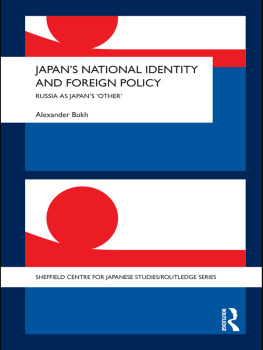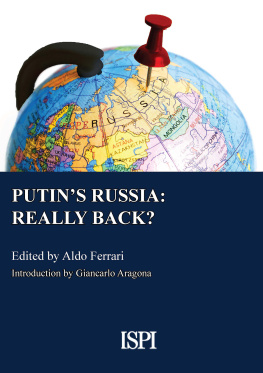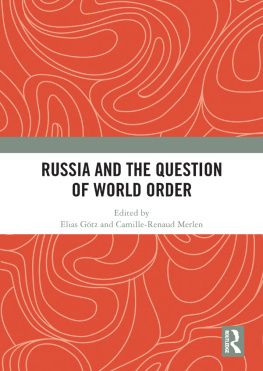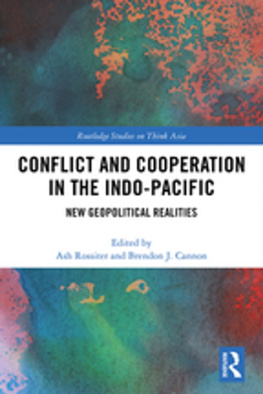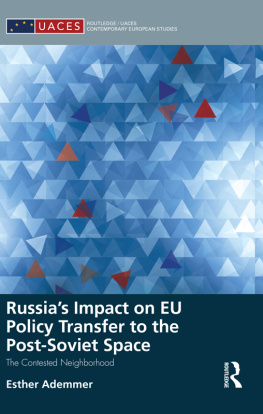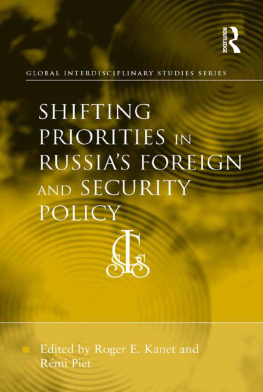First Published in India in 2017
Published by
Vij Books India Pvt Ltd
(Publishers, Distributors & Importers)
2/19, Ansari Road
Delhi 110 002
Phones: 91-11-43596460, 91-11-47340674
Fax: 91-11-47340674
e-mail:
web : www.vijbooks.com
Copyright 2017, United Service Institution of India, New Delhi
ISBN: 978-93-85563-64-5 (HB)
ISBN: 978-93-85563-44-7 (PB)
ISBN: 978-93-85563-45-4 (ebook)
All rights reserved.
No part of this book may be reproduced, stored in a retrieval system, transmitted or utilized in any form or by any means, electronic, mechanical, photocopying, recording or otherwise, without the prior permission of the copyright owner. Application for such permission should be addressed to the publisher.
The views expressed in this book are of the contributors/editors in their personal capacity and do not represent the views of the USI.
INTRODUCTION: RUSSIA LOOKS EAST
People have been debating for more than a century whether Russia is part of Europe or Asia. In Russia, opinions on the subject varied depending on the period and peoples political inclinations. Ancient Rus assimilated Christianity from the Byzantine Empire the most advanced and closest geopolitical centre of world civilization at the time. Prior to the split within the Christian church, civilization was seen as a unified whole and the question of the division between Europe and Asia did not yet exist. From the time of Peter the Great who cut a window through to Europe and throughout the 18th century, Russia was officially considered a part of Europe. Catherine the Great even put it in writing in her Nakaz (Instruction) that stated: Russia is a European power. Of course, the Empress was not referring to Russias geographic location. By emphasizing Russias connection to all European countries, she wanted to show the enlightened nature of her reign, that her country was part of the civilized world and that it was moving along the path of progress.
In the 19th century, the government of Nicholas I put forward a new official concept of Russia not as a European country, but as a special power based on the well-known trinity Orthodoxy, Autocracy and Nationality and free from the struggle between classes and landed estates. That theory was intended to provide ideological justification for the emperors overriding policy goal: protecting the country from the spread of revolutionary influences from Europe and thereby preserving the immutability of the existing social system. Members of Russian society held differing views: pro-Western thinkers called for methodically building life according to the European model while Slavophiles criticized the government for causing Russian identity to take on an increasingly formal, bureaucratic and statist nature that did not consider the native Russian or more precisely, Slavic tradition of self-rule.
That debate continued in Soviet times, although it took on a decidedly Marxist form. The theory of the so-called Asiatic mode of production meant that Russia was a part of Asia, and most ideologues argued that the Soviet Union, although travelling along a common path of human development, had taken the lead and was showing the way for others. At the same time, Russian emigrants put forward the now popular theory of Eurasianism that saw Russian civilization as the successor of some Turan (non-Slavic) Eurasian nations: Turkic, Finno-Ugric, Mongolian and others. This theory was spawned by frustration over the decay of Europe and as an attempt to explain and, at times justify rule by the clearly non-European Bolshevik regime in Russia.
Following the collapse of the Soviet Union, cooperation with Asia was no longer a theoretical question, but a practical one. The growth of the Asian economies and the geopolitical importance of the Asia-Pacific region elicited a wave of expert recommendations during the final years of the Soviet Union that called for Moscow to devote greater attention to Asian states. They managed to exert a certain influence on leaders, convincing them to pursue a normalization of relations with China. But the highpoint of the pivot to Asia came with the now-famous speech that Mikhail Gorbachev delivered in Vladivostok in 1986 in which he offered the first detailed description of the situation in the Asia-Pacific region and introduced the task of forming a comprehensive security system there. That speech paved the way for subsequent steps for achieving that goal: the opening of the previously closed militarized city of Vladivostok to international cooperation and the resolution of differences that had prevented the normalization of relations with China. However, Gorbachev was inconsistent in implementing many of the recommendations he listed in that speech, and he was further hampered by the tumultuous events of the countrys political life.
The failure of the Soviet authorities to give proper attention to the development of their own eastern territories was a weak link in their Asia policy. As part of an ideology that called for the accelerated recovery of fraternal republics, they allocated significant resources to the Central Asian republics, even while failing to make the rapid development of Russias Siberian and Far East regions an important strategic objective.
Unlike Tsar Nikolas IIs prime minister Pyotr Stolypin, who saw the need for the geopolitical development of Siberia and considered it crucial to the countrys future, Soviet leaders took a more utilitarian view of the region. During Stalins rule, his system of forced labour camps was the primary source of economic development in Siberia and the Far East. Later, Nikita Khrushchev decided to develop scientific centres in the region. In the 1970s and 1980s, the Soviet authorities established major military facilities in the region. Their presence and continued maintenance led not only to worsening relations with China, but also to the creation of new industries and social infrastructure in those territories. Even the construction of the famed Baykal-Amur Railway was motivated primarily by a military objective: it offered an important backup to the Trans-Siberian railway that ran uncomfortably close to the Chinese border. Meanwhile, that border remained on lock down, thereby preventing the Soviet Union from actively integrating with the growing economies of the Asia-Pacific countries.
Following the collapse of the Soviet Union and the loss of a number of its western territories, Russia, in a sense, moved geographically closer to Asia. Today, although the majority of its population lives in the European part of the country, two-thirds of Russias territory lies in Asia. However, opinion polls indicate that most Russians even those living on the Pacific coast and near the Chinese border feel that they are Europeans. Indeed, most Russians really are of European descent, but fate and historical circumstance have thrown them onto the Asian continent. But now having relocated, Russians must take stock of the situation and not by promoting exotic theories about their Asian roots, but by recognizing that the future of the country depends largely on its approach to and relationship with its Asian neighbours.




